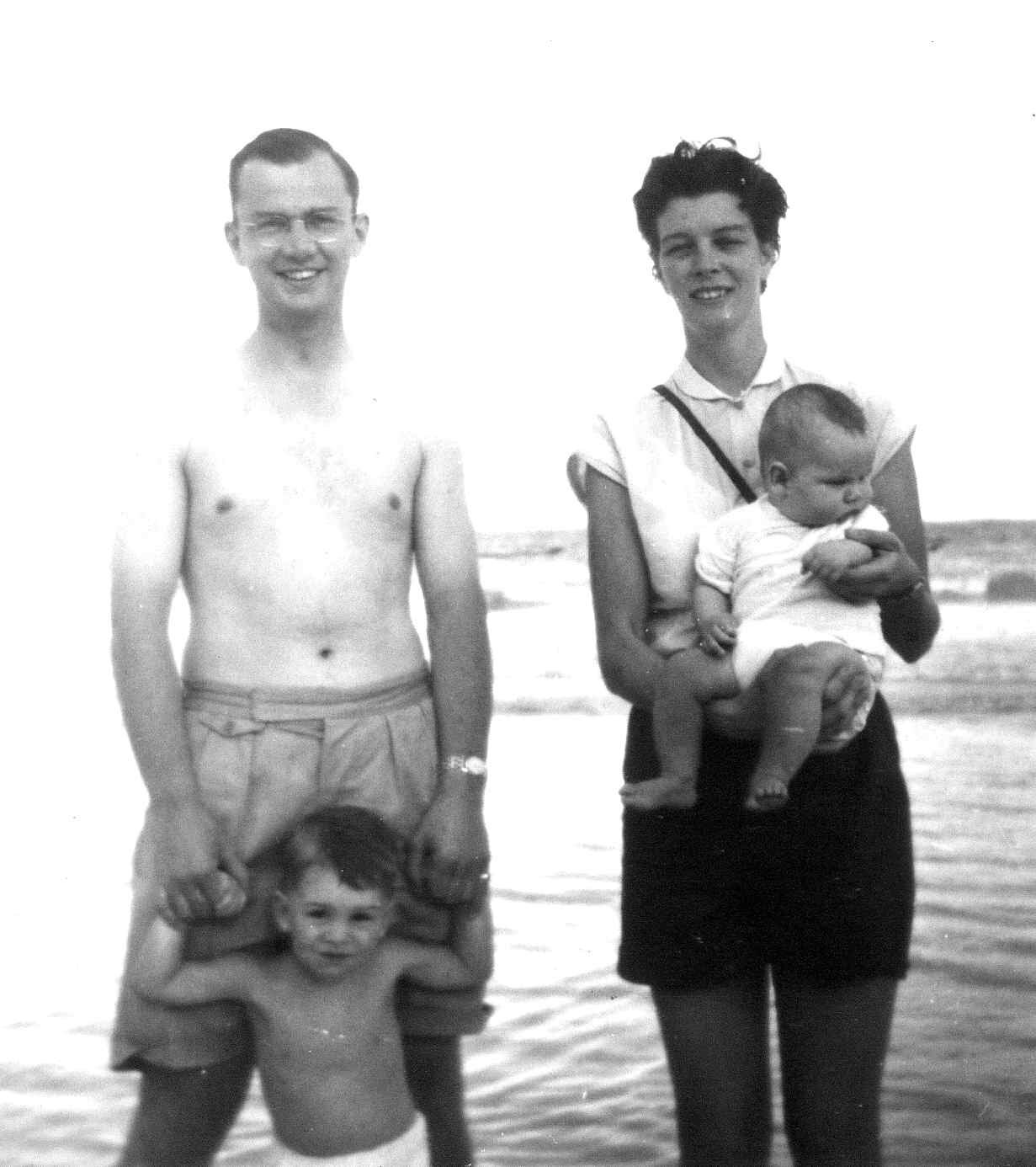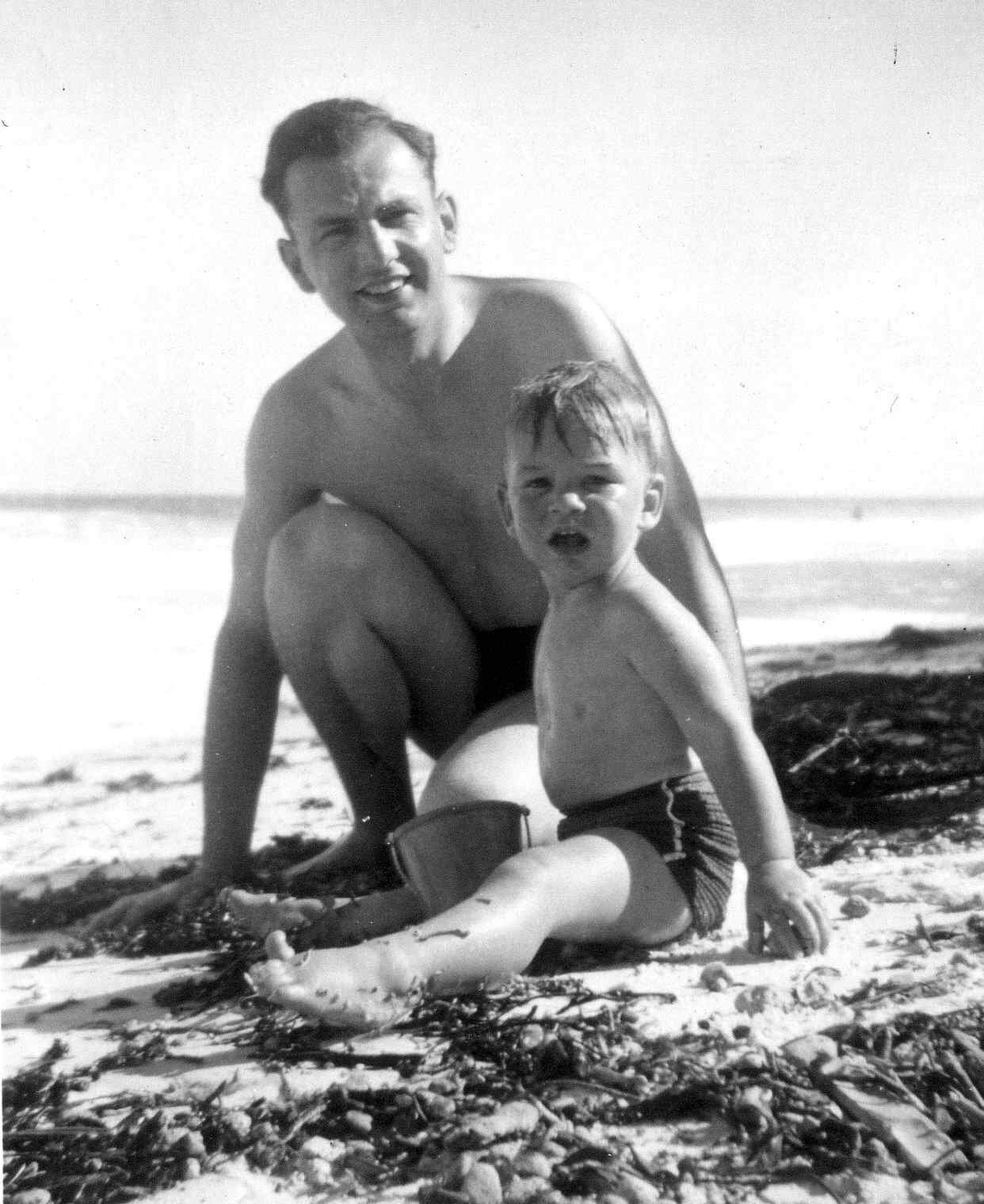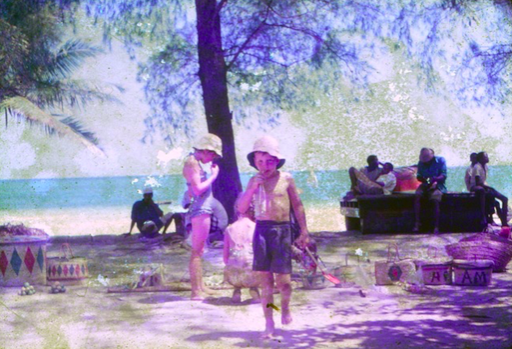THE HISTORY OF FOUR TWENTY SOUTH
1958
Four Twenty South was originally May’s Cottages, which opened its doors to guests in 1958. The blocks for its construction had been quarried from the forest behind. The first person to sign the Guest Book, Dr Portsmouth, many years later, aged 94, found his signature on our website during the Covid lockdown and emailed us from the UK which was beyond exciting. These are his photos and memories:
1960s
My brother Dominic and I amusing ourselves in the 1960s while our parents refreshed at one of the local hostelries. During this era there were only three small hotels: Jadini, the most famous of which was owned by the Trench family, Two Fishes owned by Mr and Mrs Fisch and Sandy Bay which later became the hugely popular Trade Winds. Sadly all are now gone.
My parents bought the property from the Mays in 1966, not long after Kenya’s Independence was declared in December 1963. Many Europeans and Indians, fearful of the future, were selling up and leaving the country but my parents were convinced that Kenya would thrive in its new incarnation.
Diani was a remote destination—you could only reach it via a ferry from Mombasa over to Likoni. Coconut plantations lined the road and in my teens I met a very old Dutch man whose parents had started one of them in Waa (between Likoni and Diani) at the end of the 19th Century. He told me his parents travelled across the Likoni channel on ‘ngalawas’ (outrigger canoes) with local fishermen and then his mother was carried in a litter to Waa as she couldn’t make it on foot. It’s about 15km - one long walk!
When we first arrived, Ukunda (Diani’s main town) consisted of one ‘duka’ (a general store) and a petrol station which doubled as the post office run by the Khan family who are still very much a part of Diani’s fabric. It was a tiny village and not the sprawling conurbation it is now.
My father called the property ‘Four Twenty South’ for the latitude as there were no landmarks in the forest by which to locate it. Guests love to gleefully inform us of 420’s other connotations. In America, it is a slang term for marijuana but since this was only coined in the 1970s, we were there first! Interestingly it means something else in India where section 420 of the penal code relates to cheating or trickery.
Back then, we had no electricity and relied on kerosene lamps and kerosene fridges, both of which produced heat - somewhat uncomfortable in the hot season. There was no piped water either but our well in the forest is a rare source of potable water on this beach. There were no buildings along Galu Beach south of us, only a fishing village and the Khan’s coconut plantation. To the north of us there was a house on the top of the point and we decided that the widow who lived there must be a witch and amused ourselves by peeping through her windows in the hope of seeing her flying around on a broomstick. The forest was full of bush pig and the elusive leopard who hunted them. Occasionally people would spot a lion pugmark on the beach. Sightings were rare but one night, we had a puncture on the road through the forest and as my father changed the wheel and we watched, a lioness growled, far, far too close for comfort. Now sadly, other than monkeys and small dik dik antelope there is no game in the forest and the forest itself is shrinking with the area’s rapid development.
There were only three hotels on Diani Beach then; small thatched structures: Two Fishes, Jadini and Sandy Bay. The Two Fishes (a favourite with us children as there was an aquarium with seahorses in it) was owned by a German couple called Mr and Mrs Fisch. The two other hotels were owned by the Trench family who came to Diani in the 1930s. The name Jadini was a combination of the family names, Jack, Anne (Nancy), Dan and ‘-ini’ meaning ‘place of’ in Swahili. Ernest Hemmingway came to visit and landed his plane on the beach, as most guests did, since there was no landing strip in those days.
1970s
Sandy Bay was sold and became the fashionable Trade Winds Hotel, where all the movers and shakers came and all the fun was to be had. The guest list included the now-King of England.
Four Twenty South built new extensions to the verandas in the late 1970s, but remained relatively unchanged compared to the rapid development elsewhere. Galu Beach was, and still is in the main, private houses but on Diani Beach hotels started sprouting all along the coastline. In those days they were small and beautifully designed in what was then known as Diani Beach Architecture pioneered by Spish Tzrebinski and Tibor Gal. Their aim was to make all development blend into the landscape so as to be invisible from the ocean. The hotels were ecologically sensitive before their time with grey water swamps and a nightclub in an underground cave to deaden sound late at night.
1980s
Tourism in Kenya had been steadily increasing over the decades, reaching its zenith in the late 80s with cheap flights from Europe and package holidays. The hotels grew in size as did tourist numbers on the beach and this saw the start of the age of the ‘Beach Boys’ - the hawkers who have become ubiquitous on the beach trying to befriend tourists. In 1989 my parents, my father having worked in publishing in Nairobi and my mother in education, retired here. Lots of others did the same and there was an influx of expats who moved to the area.
1990s
In the 90s there were a series of high profile murders and scandals that were deeply damaging to Kenya’s tourism and in 1997 the Likoni Riots particularly discouraged tourists from coming to Diani as the Likoni ferry was still the only way to access it. My parents long-let the property from 1997 – 2009 and lots of colourful characters made Four Twenty their home. My mother spent her time painting and making jam tarts for the Women’s Institute while my father would intersperse his daily food shopping trip with stops at Nomads and Forty Thieves beach bars.
2000s
In 2002 there was a new president in Kenya and emerging from a dark decade, the country started developing at a rapid rate. The post election violence of 2007 rocked the country but the nation and its people rebounded impressively. Over the decade I started spending more time here to be with my ageing parents and help with the business and after my father died in 2006 moved here to be with my mother until she too passed away in 2009.
2010 - present
Commercial flights from Nairobi started in 2013 which revolutionised the area, allowing Nairobians to conveniently hop over to Diani in an hour. They brought with them some of the dynamic, cosmopolitan energy of the capital and new businesses from art galleries to sushi restaurants started to appear. The 2019-22 Covid crisis, while devastating in its impact, also ushered in a new era of working from home and has encouraged a new influx of Diani denizens.
Over the last decade, my husband John and I undertook the task of slowly renovating Four Twenty South. The plumbing was vintage 1958 and the lead pipes had collapsed inside allowing not much more than a pin prick of water to trickle into the system. Roofs leaked, wiring was ancient, beams and ceilings were collapsing and the floors were painted with red paint in a bad imitation of terracotta tiling as was common in pre-independence Kenya. Starting with the infrastructure we have been working to bring the facilities and accommodation up to modern standards without destroying the unique authentic character which we and our guests love. It is still a work in progress.
In May 2022 Dominic, my brother, and his wife Carol took over management of the three houses on their side of the property.



